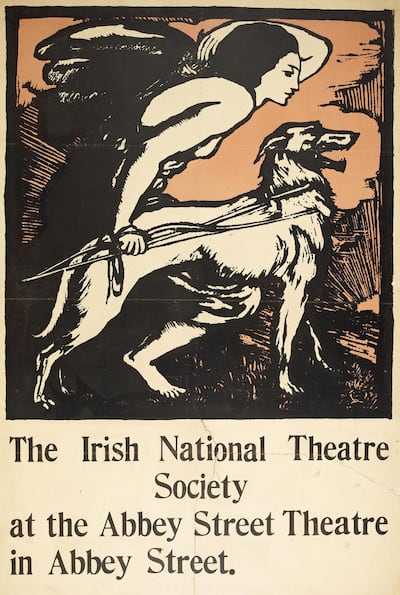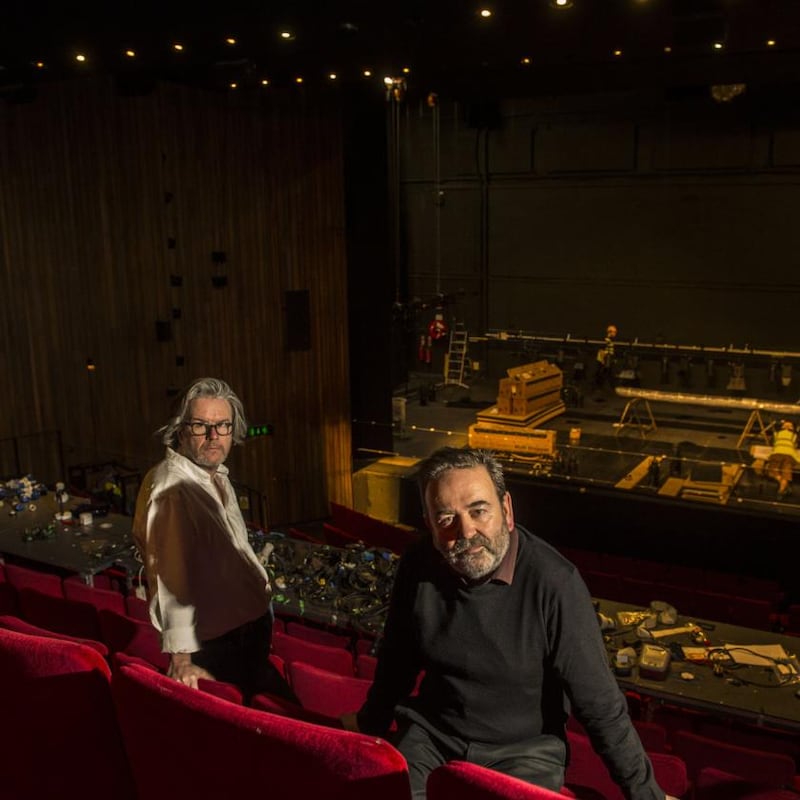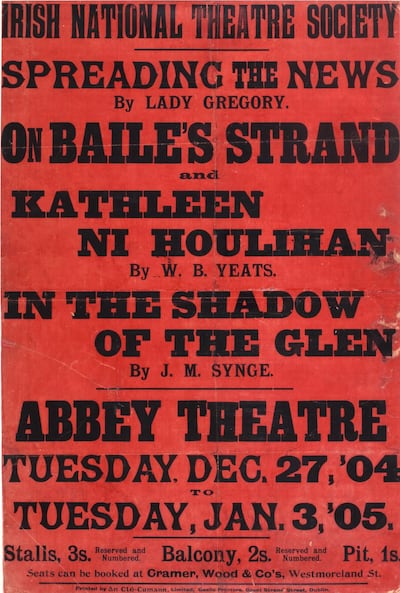In James Joyce's Ulysses, Buck Mulligan has some scabrous comments on his theatregoing experiences: "We went over to their playbox, Haines and I, the plumbers' hall. Our players are creating a new art for Europe like the Greeks or M Maeterlinck. Abbey Theatre! I smell the pubic sweat of monks."
Ulysses is set on June 16th, 1904. The Abbey Theatre actually opened its doors on December 27th, 1904. Mulligan’s bitching about the theatre and mockery of its ambitions to create a new European art is, shall we say, a bit previous. One of Dublin’s favourite pastimes – complaining about the Abbey – is being indulged even before there is an Abbey to disparage.
The Abbey is in the throes not just of its usual botheration but also of a profound uncertainty about what it is for
This may be some consolation to the current codirectors of the national theatre, Graham McLaren and Neil Murray, whose stewardship is increasingly uncomfortable. The Abbey is embattled again – but when was it not? Even some of its greatest moments, such as the premieres of John Synge's The Playboy of the Western World and Sean O'Casey's The Plough and the Stars, were greeted with howls of protest and riots in the auditorium. Arguably the most influential Irish dramatist of the 20th century, Samuel Beckett, in his first novel, Murphy, has a character instruct in his will that his ashes be flushed down the lavatory at the Abbey, "if possible during the performance of a play".
It was said that my old employer the New York Daily News, in the days of compositors, kept “Judy Garland takes overdose” in permanent type. Irish newspapers for many decades kept, metaphorically at least, “Abbey in crisis” in permanent type. I myself, in my time as a drama critic, wrote pieces under similar headlines every few years. So this is a story as old as the Abbey itself – indeed, as Ulysses reminds us, even older.
And yet just because an institution has always been in crisis doesn’t mean it’s not in crisis now. A sense of perspective is certainly required, but it does not banish the thought that the Abbey is in the throes not just of its usual botheration but also of a profound uncertainty about what it is for. The theatre is supposed to embody some kind of statement about Irish identity, but its own identity now seems deeply confused.

The first big question about the Abbey is whether it is currently a world-class theatre. That may seem an excessively high bar, but it is set by the theatre’s own mission statement: “The Abbey Theatre’s mission is to create a world-class theatre.” Or rather, it was. Under the current regime, the Abbey has quietly dropped this ambition. Its stated mission now is “to imaginatively engage with all of Irish society through the production of ambitious, courageous and new theatre in all its forms”. A certain falling-off is there.
Admittedly, the change follows from the last big Arts Council review of the Abbey, conducted in 2014 by the consultants Bonnar Keenlyside, which pointed out that “world-class” is “difficult to evidence”. That seems fair enough, but it does raise the awkward question of the relationship between the Abbey’s present and its past. For there have been times in which it was quite meaningful to think of the Abbey as having global importance for theatre as an art form. Its founders did think of themselves in that way and at least some of the time the world did not find their high notions risible.
And now? “World-class” may be impossible to calibrate in any objective way. But two things are plain enough. One is that the Abbey doesn’t really want to be judged by world standards. And the other is that the world pretty much agrees with the Abbey on this. It produces a lot of good theatre, some of it of the highest international calibre. But it is fanciful to think that many critics would currently list it as one of the world’s great theatres. It isn’t.
If there is a dominant aesthetic at the Abbey now, it is adaptation: from novels and movies. Is this what 'ambitious, courageous and new' Irish theatre is meant to look like?
Maybe this does not matter very much in itself. But McLaren and Murray were hired by the Abbey because of their work at the much-admired National Theatre of Scotland, where McLaren was an associate director and Murray was executive producer. And what does the Glasgow-based company set as its mission? To be, over the next decade, “known as the most audacious and innovative national theatre in the world” and to“create exceptional work and showcase it all over the world”. Is that a ridiculous ambition? If it is, it does not seem to weigh the Scottish company down.
How does the Abbey under McLaren and Murray compare to their former home in Scotland? The National Theatre of Scotland gets £4.17 million, or about €4.7 million, annually from the Scottish government. The Abbey gets significantly more from the Irish Government: €7 million a year. In 2018, the National Theatre of Scotland staged 68 shows. The Abbey staged 26. (It has a three-year average of 49 productions in 2017-19.) The National Theatre of Scotland staged 29 world premieres in 2018. The Abbey staged 10. These numbers tell us nothing about quality, of course, and artistic judgments will always be subjective. But in terms of current reputation, few international critics would dispute that the National Theatre of Scotland’s is higher than the Abbey’s.

This points to another question, one that goes to the heart of the Abbey’s identity. Why was the Abbey ever in any meaningful sense “world-class”? The answer is simple enough: the writers. For almost all of its existence, what people in Ireland and around the world primarily associated with the Abbey was the literary play. This is not to say that actors, directors and designers were ever incidental. But those artists and performers saw themselves as bringing to life and embodying the visions of playwrights.
There are other kinds of theatre, of course. The literary play is not everything. But it just happens to be the case that Ireland has an extraordinary history of theatre built around dramatic texts. It’s a form that’s been around for thousands of years, and in any global history of those millenniums Irish figures have to be given a prominent place. There is, moreover, no reason to think that this tradition is dead. Irish writers, including many very good ones (and very much including Irish women), are still grappling with it.
But here we come to the one of the most problematic sides of the current regime: McLaren and Murray are not interested in this tradition. As the leading theatre critic and historian Patrick Lonergan recently wrote of the Abbey in The Irish Times, "the current directors have taken an unprecedented step in programming three seasons without staging plays by Sheridan, Goldsmith, Boucicault, Wilde, Shaw, Yeats, Synge, Gregory, O'Casey, Friel, Murphy and most of the other dramatists who have made Irish theatre internationally significant."

Nor are they apparently much interested in the international dramatic repertoire either. Indeed, if there is a dominant aesthetic at the Abbey now, it is adaptation: from novels (The Country Girls, Asking for It, Ulysses, Anna Karenina, Room, Frankenstein) and movies (Jimmy’s Hall, Let the Right One In). To get on to today’s Abbey stage, it helps a lot if the work is already familiar from print or screen. Is this what “ambitious, courageous and new” Irish theatre is meant to look like?
It’s certainly not what the Abbey as an institution thinks it is supposed to look like. Its current mission statement still begins with the words “Inspired by the revolutionary ideals of our founders and our rich canon of Irish dramatic writing…” These words are hollow to the point of mockery. Whatever else one might say of McLaren and Murray, it is obvious that they are not inspired by Yeats, Synge and Gregory. And equally obvious that “the rich canon of Irish dramatic writing” is, to them, at best a bore. The theatre’s five-year strategy claims that “interpretations of the rich Irish theatre repertoire is a core part of our vision”, but it seems to be core only in the sense of being buried so far underground as to be invisible.
As a matter of taste, this is a perfectly legitimate position. But as a position from which to run the Abbey, it is a bit like having the National Concert Hall run by people who think classical music is a dead form or Wexford Festival Opera run by someone who can’t stand all that ridiculously grandiose singing. Or, to change country, to have people at the head of the Royal Shakespeare Company who think Shakespeare is just so passe. There may be good reasons to do it, but it raises an obvious question: would the State be putting €7 million a year into a national theatre that had the honesty to say that it just doesn’t care about the national tradition of dramatic writing?
If the Abbey is not about its own tradition, the very least it might be is the primary sustainer of the theatrical profession in Ireland. But of course, as open letters in January and last month from 425 leading theatre professionals have articulated, that's not happening either. The revelation that not a single Ireland-based actor appeared in an Abbey Theatre production on an Abbey stage between September 8th, 2018, and February 23rd, 2019, was mind-blowing. Not a single Abbey contract was given to an Ireland-based set designer on the main stage in 2017 or 2018. The Abbey's claim that it exists to "nurture Ireland's artists" has been increasingly divorced from reality.
The Abbey's five-year strategy document amounts, without the window dressing, to a shockingly paltry 10 pages of corporate verbiage
The Abbey board, in the words of its chair, Frances Ruane, appointed McLaren and Murray to "reimagine the production model of the Abbey", and they've certainly done that by increasing the kind of coproductions that have been successful for their alma mater in Scotland. But for most of those who actually work in the Irish theatre, "collaboration" has translated into dependency and vulnerability. The Abbey's €7 million annual grant is more than three times the public funding for than the next two best-funded theatres – the Gate, in Dublin, and Druid, in Galway – put together. It shapes the entire ecosystem of Irish theatre, and that ecosystem is one in which many life forms are struggling to survive.
If the Abbey is not a world-class theatre, is not interested in the canon of Irish drama and has been worsening the conditions for most theatre practitioners, what is it for? One searches in vain for an answer in its five-year strategy document, which amounts, without the window dressing, to a shockingly paltry 10 pages of corporate verbiage. The Abbey hails itself as “one of the world’s iconic playhouses” while saying nothing about how it might have become so once upon a time or about the relationship of its present and future to that past. It claims that “our founding principles are never more relevant than they are today” but shows no interest in telling us what that relevance might be.
If all goes to plan (which in Ireland it seldom does) the Abbey will move to a new building in 2024. If it really has no interest in its own past, this would be a good time to say so. As it prepares to move, it can also prepare to move on and ditch the history that it seems increasingly to regard as unwanted baggage. That, however, would leave the Government with two big questions: what is to be done with all that old drama that Ireland was so famous for, and who is going to do it?

















